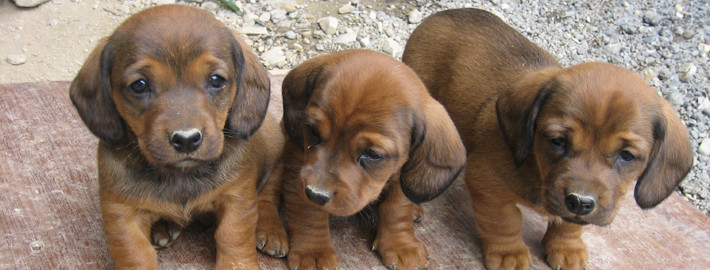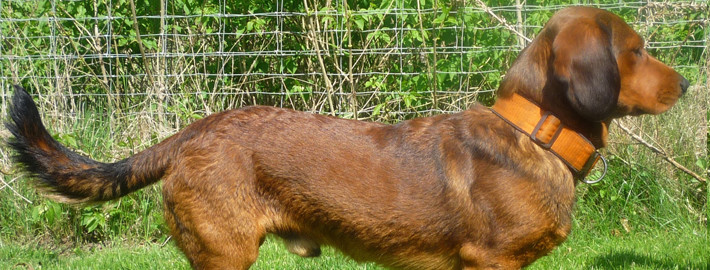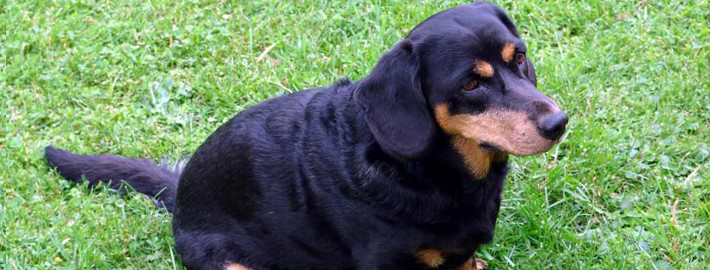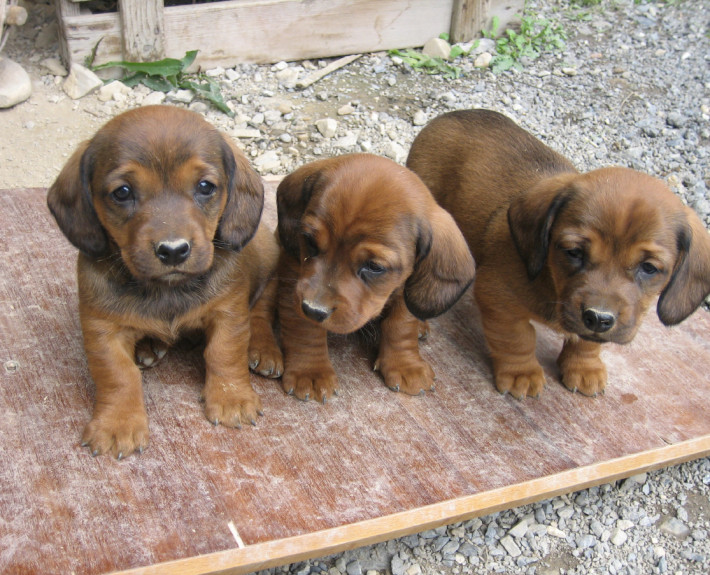What makes the Alpine Dachsbracke Unique?
Friendly, energetic, and intelligent, Alpine Dachsbrackes make great pets for any location. Many members of this breed are still serving their original purpose as hunting dogs rather than serving as family companions, but they can easily fulfil both roles. Though this rare breed may greatly resemble wirehaired dachshunds in appearance and temperament, Alpine Dachsbrackes are not exactly the same as their ancestors.
Breed Groups
- Hound Dog Breed
- Small Size
Page Contents
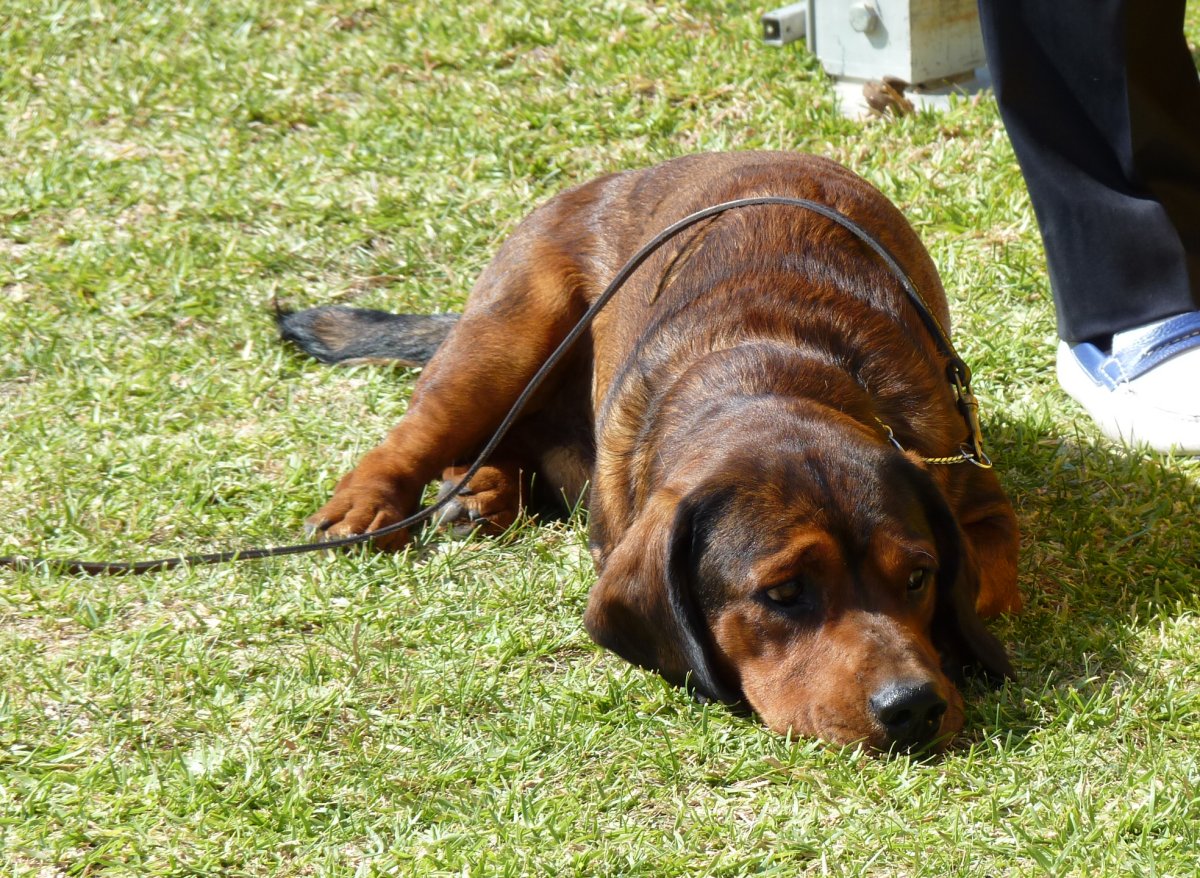
Is the Alpine Dachsbracke Right For You?
The Alpine Dachsbracke is a breed of dog found mainly in Austria where they are known as Alpenlandische Dachsbracke. In ancient times, hunters used a dog similar in appearance to the Alpine Dachsbracke for tracking and hunting. Hunters needed a dog that could track and hunt game in the high altitudes of Austria. Hence, they developed a dog with short legs from the indigenous dogs of Austria. Larger than the German Westphalian, these dogs can be used to hunt deer, rabbit, and fox. From 1881 to 1885, King Rudolph of Habsburg insisted on using these dogs for his hunting expeditions to Turkey and Egypt.
In 5 Words
- Intelligent
- Friendly
- Fearless
- Confident
- Hard-headed
Characteristics
Learn About the Alpine Dachsbracke
Description
General Description
Alpine Dachsbrackes are categorized by the F.C.I (Fédération Cynologique Internationale) as scent hounds, in the leash or scent hound subsection. They are used as tracking hounds for wounded deer and as scent hounds for hare and fox. Members of this breed are generally robust and sturdy working dogs, which were bred to withstand the harsh mountainous conditions of their native lands.
Overall, this is a small, but muscular, dog breed. According to breed standards, Alpine Dachsbrackes should have black noses, strong muzzles and tightly fitting lips. These strong boned dogs should have brown eyes with black irises. They should have elongated bodies with a broad chest, short legs, a tucked up belly, and a high set, brush style tail. Their skin should be elastic, but not wrinkled. Alpine Dachsbrackes should move at a trot to cover ground quickly without tripping.
Size
The standard size for this breed is between 34 cm. to 42 cm. (13 to 16 inches) at the shoulder blades or withers. If competing, male dogs should ideally be between 37-38 cm. and female dogs should measure 36-37 cm. at the withers. Alpine Dachsbrackes weigh around 33 to 40 pounds, or 15 to 18 kilograms, on average.
Coat
Alpine Dachsbrackes have a dense undercoat and a heavy top coat to help them withstand the cold regions where they originated. The breed comes in a standard color of dark red with black hairs throughout, though black dogs with reddish markings on their bodies and heads are not uncommon. Alpine Dachsbrackes may also have a white splash on their chests.
Short History of the Alpine
While hunting dogs similar to the Alpine Dachsbrackes have been used in Austria and Germany for a long time, the more modern version has existed since at least the 1850s. The Alpine Dachsbrackes were created by taking traditional, larger Austrian hounds that were used to the rough terrain of the Alps and cross breeding them with smooth coated, standard-sized Dachshunds. Hunters during the time period thought it was dishonorable to leave a wounded deer to die of its injuries. Therefore, this breed was developed in order to track these animals, so that they could be killed without prolonged suffering.
Though initially intended to hunt wounded deer, the Alpine Dachsbrackes proved themselves to be excellent hunting dog and quickly expanded their repertoire by catching boars, foxes, hares, and other types of game. This breed has long been a favorite in Austria, especially among nobles. In fact, several Alpine Dachsbrackes accompanied Prince Rudolf of Hapsburg on his hunting trips to Egypt and Turkey in the 1880s.
The scent hound breed was officially recognized in 1932, under a slightly different name. In 1975, the breed’s name was changed to Alpenländische Dachsbracke or, in English, the Alpine Dachsbracke. They were next classed as a leash hounds in 1991.
Temperament
Used effectively to track wounded deer, this fearless breed can work even in harsh terrain and high altitude. Being both friendly and intelligent, Alpine Dachsbrackes make good companions. As they are primarily a working breed, these dogs are kept mostly by hunters. Yet they are quite sociable due to the fact that Alpine Dachsbrackes were bred to work with people and teams of other animals. Most dogs of this breed are excellent with both children and other animals, though they may exhibit a strong prey drive typical of many scent dogs. Like most breeds, they benefit from early socialization. Shyness or aggressiveness in Alpine Dachsbracke is considered to be a fault, especially in the show ring. This breed does best in rural environments, but can adapt to city life if given enough exercise.
Caring for Your Alpine Dachsbracke
General Health
Currently the breed does not suffer from any specific genetic diseases. Like dachshunds, Alpine Dachsbracke can be prone to back injuries due having an elongated back, and this is made worse if a dog develop a tendency to overeat. Most senior dogs of all breeds are at a heightened risk for hip dysplasia and this holds true for the Alpine Dachsbracke as well. In good health, this breed will live about ten to twelve years.
Alpine Dachsbracke can adapt to apartment life, but need to receive plenty of exercise or they can become destructive. In cities, it is never a good idea to allow a Dachsbracke off its leash. Their strong prey drive will cause them to chase any small animal that crosses their path, such as squirrels, and this could be dangerous for both owner and dog alike.
Care
Daily
Alpine Dachsbracke were bred to hunt and have great vitality and stamina as a result. Therefore, this breed requires plenty of exercise. Daily walks are needed and they relish the outdoors and hunting trips. These dogs also enjoy running around a fenced in backyard, but should nonetheless be supervised as they enjoy digging and are prone to escape.
Weekly
Due to their heavy coats, a weekly brushing is a good idea. The frequency of brushing should be increased whenever the Alpine Dachsbracke are shedding to prevent households from becoming covered with fur. A daily or even weekly cleaning of a Alpine Dachsbracke’s teeth will help prevent the onset of periodontal disease, which can result in bad breath. There are plenty of toothpastes and toothbrushes now on the market for dogs.
Monthly
Like any other breed, the Alpine Dachsbracke should be treated for heartworm, ticks, and fleas on a regular basis. Thier nails should also be trimmed as needed.
Grooming & Bathing
Brushing and bathing dog of this breed should occur on a regular basis. Owners can choose if weekly or daily brushing suits their dog’s needs best. Bathing them on a monthly basis is a good idea, as Alpine Dachsbracke are a hound breed of dog and can start to smell if kept unwashed for long periods.
Exercise & Training
Be sure to remain the dog’s confident and consistent pack leader to avoid unwanted behavior issues. A firm hand is required, yet the Alpine Dachsbracke may still ignore its owners if it smells something particularly interesting. Even so, members of this breed are usually quick learners and fairly easy to train. Some enjoy performing tricks. Positive reinforcement and rewards based training are the best way to manage Alpine Dachsbracke. However, if treats are passed out as a reward, take care that the dogs should not overeat.

